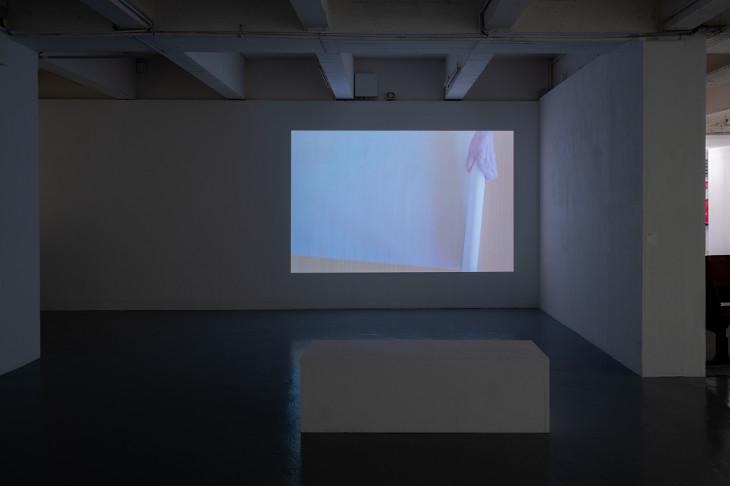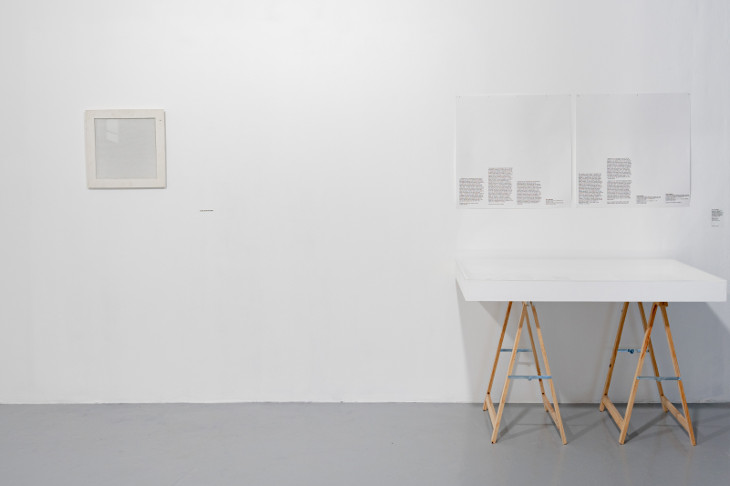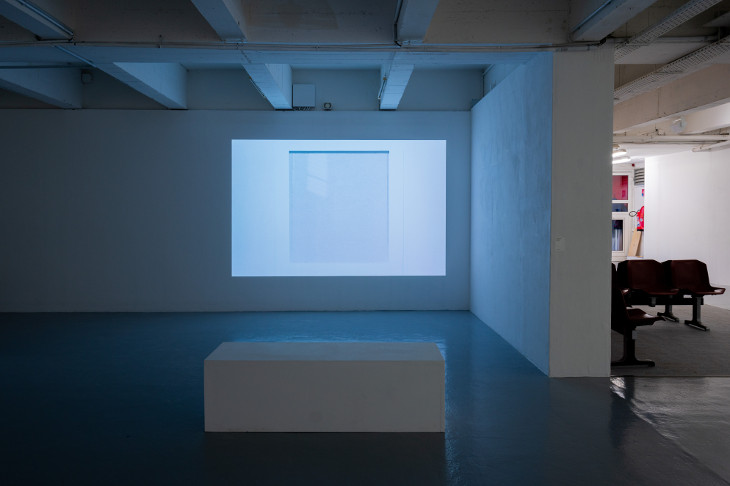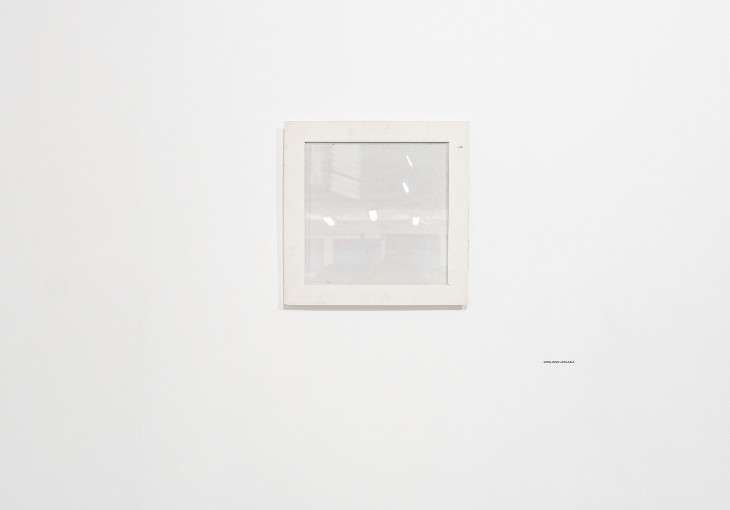The Intolerable Straight Line
*Silvia Kolbowski, Enlarged From the Catalogue: Michael Asher writings 1973-1983 on works 1969-1979 (the press of the Nova Scotia College of art and design and the museum of contemporary art, Los Angeles 1983), 1990*
Framed photograph, wall label, folded catalogue.
Silvia Kolbowski, Missing Asher, 2019
Film, 16min 42s.
The following is an interview with the artist conducted by Maud Jacquin and Sebastien Pluot.
*What was your state of mind – and the state of your work – when you decided to make Enlarged from the Catalogue: Michael Asher...?*
At that time I was feeling very frustrated about the mis-match between my way of working and the ways in which non-museum exhibitions were organized. In the 1980s I had been part of a loosely-aligned group of "appropriationist" artists (Cindy Sherman, Laurie Simmons, Richard Prince, Louise Lawler, Barbara Kruger, and quite a few others). But my manner of working was, by the late 1980s, somewhat different than theirs in that I was interested in the legacies of site-specific work, and they were working with the conventions of the edition in regards to photography, which was more tied to the conventions of studio practices.
I was, in a way, sandwiched between Michael Asher’s generation of conceptual artists – which was more used to art institutions accommodating site-specific processes – and that of the appropriationists, who moved into the art market by the late 1980s. I spent a difficult year – 10989 – thinking about leaving the field of art altogether because I was afraid that my work was going to get shut out in not taking a commercial form as the art market was becoming a defining institution. I did not relish making art that might not get exhibited for those reasons. The power of galleries in regards to establishing an artistic reputation was growing, and although I was with a gallery in the late 1980s, it was not a gallery with power. But after that year of painful reflection, during which I considered entering the fields of law or architecture or film, I found myself returning to art as the form of discursive and creative expression that felt most vital to me. It was during the same year as I did the Asher project that I switched course in my work and began to make works in urban contexts in a dematerialized manner, starting with my Harry Winston project (An example of recent work may be found in the windows of Harry Winston Inc., from approximately 5:17 to 5:34 pm, 1990). This work was uncommercial with a vengeance!
Can you tell us about the series of works entitled Enlarged from the Catalogue to which Enlarged from the Catalogue: Michael Asher... belongs?
I developed six projects under that title between 1987 and 1990. I saw the generic exhibition catalogue as a convention that tended to reinforce the singular viewpoint of a thematic exhibition and its institutional view, and I became interested in opening that up to inquiry. Each of the four projects took a different form. Enlarged from the Catalogue: The Art of Pre-Columbian Gold, The Jan Mitchell Collection (1987) looked at the contradictions in collector attitudes toward objects from that period (objects both valuable and abject). That title also encompassed two works that took the form of grids of framed elements and texts.
Enlarged from the Catalogue: The United States of America (1990) looked at the American wing holdings at the Metropolitan Museum, New York, and how it told a particular story of the United States based on curatorial selections. That project also included a new small catalogue that overlapped the museum’s holdings with material they would never have considered including. Another project took the form of a collection of found catalogues during a particular month, and the Asher project addressed the genre of group shows in relation to one of Michael Asher’s own projects about group exhibitions. These projects tried to trace the flows of cultural discourses (and, implicitly and explicitly, politics) that circulated out of museums.
What was your relationship to Michael Asher’s work and to the notion of site-specificity in general? How has it evolved since then?
I discovered Asher’s work around the late 1980s, through my growing interest in Conceptual Art of the 1960s and 1970s, as a way of answering some questions I had about form. My contemporaries in art were playing within the image, and with genres, but not so much with questions of display or space or spectatorship. It’s hard to imagine now, with a renewed interest in art of the 60s/70s, and perhaps especially hard for Europeans to imagine, since their interest in conceptualism never fully disappeared, but the American art scene in the 1980s had completely repressed Conceptual Art as it had developed in America, Europe, Asia and South America. In those days, I was teaching at the Whitney Independent Study Program in New York, and guest-teaching in various schools in the U.S., and my students had no idea what Conceptual Art was, nor did they have an interest in it when I mentioned it. You could say that for American artists (and also for art historians and critics) what survived the art of the 1960s were the Warholian strains of that period – a focus on image worlds (the title, in fact, of a 1990 group exhibition at the Whitney Museum in which my work was included.) This is not surprising, because the explosion of advertising in the 80s and 90s was mammoth, and in part some critical art practices were responding to it.
But I was very uncomfortable with taking form and spectatorship for granted and just working within the image or by mimicking advertising. So when I discovered Michael Asher’s great line – “Why put art on the wall, why put art on the floor?” – I felt strongly that I had found someone whose work could help me answer some questions that I had about form in relation to cultural critique.
So I started to work in a more site-specific manner, albeit very differently from the way the conceptualists had worked in the 1960s and1970s. The first of these works was an example of recent work may be found in the windows of Harry Winston Inc., from approximately 5:17 to 5:34 pm (1990) which involved selecting an urban site and working with the paratextual materials typical of art exhibitions – advertisements, invitation - to draw people to the site, but not altering the site at all. Instead, the work aimed to re-frame the site. Another work of this kind was These goods are available at ______ (1995) which involved moving window displays around the city of London in a very precise circuit so as to create cultural disjunctions for the shopper/spectator. But woven throughout my site-specific works of the 1990s was an approach that I developed called “site-transferability.” That was my attempt to deal with the rampant globalization of art, a growth that had of necessity emphasized the generic white cube exhibition space and an underplaying of national and cultural differences. Instead, my projects of this period emphasized cultural specificity, but were devised so as to accommodate different sites. I was aiming to make the generic more specific.
But the reality was that by the mid-90s conventional exhibition formats made it difficult for me to work even with site-transferability – curators wanted to look at an existing body of work, galleries wanted to focus more and more on commercially viability, museums were more and more influenced by commercial galleries. Also, the unbelievable explosion in MFA programs, which drew more and more young artists into the field (most functioning under the illusion that art was a road to “the good life”) altered the field of art so that the competition for attention was much more daunting than it had always been, and, for me, very unpleasant to navigate. So by the late 1990s, after years of post-studio work, I decided to retreat to the studio and work with video/film in order to gain a modicum of control over what I produced. In other words, if I developed my time-based work at my own pace in my studio, I could also determine its content, rather than relying on an external institutional demand, or even wondering if that demand would arise. Some of the studio works include – in installation - a spatial component, but it’s not a major one and not always essential to the work. And by working with video, I can employ a given form and experiment within it – history is embedded not only in the work’s content, but also in its formal experiments.
In a text that you wrote in the context of the Munster Sculpture Project in 2017, you coined the term “psyche-specific”, which we find quite intriguing. What did you mean by that?
For that context, which was a response to a question about whether the importance of “institutional critique” persists today, I formulated the term psyche-specific because as a homonymic pun it contains a reference to site-specificity while trying to make an argument about what can follow institutional critique and site-specificity now that the current historical moment has made them both irrelevant. In that response I tied together institutional critique and site-specificity, because I think that the best institutional critique (like Asher’s, until his death) was also in various ways site-specific. But what was missing from both of those approaches was an understanding of the psychical dimensions of the spectator (something I’ve been interested in since the late 1970s). And in the 21st century that lack has really had a deleterious effect on the critical nature of those two aesthetic approaches (if it hasn’t rendered them obsolete) because so much of what is happening at this late stage of neo-liberal capitalism involves the clever psychical manipulation of capitalism’s subjects by those in power (inside and outside of government), and the overtly unashamed display of power, so that “exposing” lies or power – the basis of much institutional critique and of critical site-specificity - no longer has the effect of shaming power. In fact, even in the 1980s and 90s I was not sanguine about the art that relied on exposure. I believe that artists interested in a critique of institutional power need to pay attention to the psychical dimensions of power in the culture, and in spectatorship.
Regarding the historicization of artworks, we are interested in the fact that instead of simply re-presenting your 1990 piece, you decided to translate it for the present by tracing its trajectory through time and space. Why is that? And is it something that you have done in relation to other works?
My initial motivation for tracing the trajectory of my 1990 work came from my distaste for the documentary presentation of art works that cannot be properly displayed years after their original exhibition because of the nature of their materials or their brief temporality or just their disappearance. Ephemera is interesting, but for me it is underwhelming as exhibition material,and as I suspect it is for spectators. I first dealt with this problem in 2010 when I was asked by Axel Wieder to exhibit my Harry Winston project in the exhibition "Dissociation" at Kunstlerhaus Stuttgart. They wanted to display documentation of a project that never had any physical form other than an existing urban site framed by an invitation and an ad. So I suggested to them that I make a powerpoint that would explain the project, which they then projected in the space, although I might have thought up something more ambitious if the lead-up to the show hadn’t been so short. But I did like the idea of telling a story about a project that no longer existed.
With the re-presentation of the Asher work, I was also dissatisfied with the suggestion to display ephemera and a caption. I wanted to bring the work to life for the spectator in some way, across time, and I happened to remember two aspects in relation to that work that always intrigued me – firstly, that the work sold twice during the month the piece was up in the gallery in 1990, and secondly, that I had a vague memory that someone had once told me that they had seen it a few years later in an online auction, selling for very little money. I think a lot of my work involves a kind of investigative approach; it’s a method that I find very intriguing – the unearthing of knowledge of some kind and then the process of figuring out how to give it form in a way that will be meaningful to the spectator, and to its historical moment of display.
It’s also the case that when I installed an inadequate history of conceptual art at the Center for Contemporary Art in Warsaw in 2007, I asked the curators if I could stretch the reading of the work in its national setting by including the projection of a Polish film in an adjacent room, a film which I thought inflected the reading of an inadequate history in a relevant manner. You could say that was a form of translation of my own work also.
How do you think Enlarged from the Catalogue: Michael Asher... resonates in the present context, in particular with regard to the relationship between individualism and collective practice?
It could be said that currently, in the U.S. and worldwide, there are various signs of dire struggles between the 1% and the 99%, or maybe the 20% and the 80%. Regardless of the percentages in particular locations, these are dire struggles for an equitable distribution of wealth. In the U.S. and elsewhere these struggles are hampered by a many-decades-long psychological war to convince people that individualism can be equated with democracy, and collectivism with anti-democratic forces, whether they be called socialist or communist. This act of shaming is arguably the most destructive tenet of neoliberalism, and it has been very effective. Without addressing that aspect of contemporary capitalism – i.e. making it compellingly clear to people in some way that they are not individually responsible for their economic precarity – there is no hope for equity.
Not having looked at the textual material from Enlarged from the Catalogue: Michael Asher... for almost two decades, I was surprised at how much it resonated for the current situation. But perhaps that’s not surprising, because the ideology of individualism has only become stronger and more phantasmatic over that period. This is the phantasm that must exist for capitalism to be conflated with a democratic norm.
I did not intend then, nor did I grow more interested in privileging collective aesthetic practice. I am interested in any kind of aesthetic practice that takes a critical approach to its context, whether it refers directly to it or not. Collective aesthetic endeavors are not inherently critical and progressive, just as individual aesthetic practices are not inherently reactionary. For me, in regards to art, it’s really about the work itself, and less so about the mode of working. That said, I am very attracted to Alain Badiou’s conjecture that artistic practices will, in the future, become more anonymous and collective (he compares it to the practice of science today, which has no particular attachment to auteurship).
In the catalogue for the 1990 exhibition L’art conceptuel: une perspective which took place at the Musée d’Art Moderne de la Ville de Paris, Michael Asher wrote a text explaining the reasons why his contribution consisted in concurrently publishing the announcement of the exhibition in art journals as a way to “accelerate the process of historical objectivation (…) while a collective memory and experience still exist”.
In 1997, you made a work called an inadequate history of conceptual art about which you wrote that you wanted to slow down the process of historicization of conceptual art. What did you mean then and what are your thoughts about this today?
That is an interesting comparison. But I think that Asher was wrong to assume that a “collective memory and experience” of Conceptual Art existed in 1990. Maybe it did in his small circle of peers or of European curators who supported him, or in his small circle of art students at Cal Arts, where he was rightly a beloved professor. I can tell you definitively that Conceptual Art of the 1960s and 1970s had no currency in 1990 in New York. So he was either being hopeful, or he knew exactly how little collective memory existed and he was being rhetorical. In the 1980s I taught for a few weeks in a University an hour from Cal Arts in Los Angeles; it was not as hip an art program as the one in which Asher held a revered place at Cal Arts, where I had also guest taught. None of the students that I met with in the various art programs in which I guest taught in those years knew what Conceptual Art was, let alone valued it. As I mentioned, not even in the Whitney Independent Study Program did Conceptual Art have currency until the mid-to-late 90s, and then mostly for the art history doctoral participants in the program. I remember being surprised to see the shift in dissertation topics to the 1960s. The WISP students, in 1990, were more caught up in practices that were quite distant from the approaches of historical Conceptual Art– they were more commonly equating activism with critical art, for example.
By the time I started making an inadequate history of conceptual art, in 1997, that had changed. But my motivation for aihca – which you are right in saying aimed to slow down the process of historicization – came from the fact that “neo-conceptualism” had gained strong currency in discourse and practice then, and I saw it as a complete distortion of the tenets and practice of historical Conceptual Art. So my call to slow down the process of historicization through my project was based on the fact that the newly coined category “neo-conceptualism” was rapidly swallowing the historical practice and distorting it dramatically. Also in that project, I was responding to "L’art conceptuel: une perspective" and other shows like it, which defined historical Conceptual Art so narrowly that almost no women were included in their effort at historicization. Maybe Asher thought that accelerating the process of objectivation would have rescued Conceptual Art from dramatic distortion, but let’s at least note that he agreed to participate in an exhibition that had almost no women in it. Asher was one of two artists who most influenced me, but of course he had his blind spots.
The question of translation is central to your work, as is the idea that the past transforms and is transformed by the present (and vice versa). Do you think of the process of translation as an ethical way of relating to historical works and to the past in general? And if so, why and how?
This is the question that answers itself! But seriously, I do think that the relationship between the past and the present is a vitally important one in a culture that has an extremely short attention span – and conveniently so for a neoliberal capitalism that is fed by that, and which would like to rewrite history – if at all – in its own image. When you have Barack Obama praising the fairness and decency of Ronald Reagan in 2019, you know that something is very wrong in the transformation of the past by the present. That is already one form of translation, albeit an unfortunate one. So it isn’t translation per se that can be equated with an ethical way of relating to historical works, because of course all translation involves transformation. Rather, we could think about an ethical process of translation as an important way of relating to the past, with the understanding that transformation is always inherent to translation. One has to take an ethical responsibility for that transformation, while still understanding that we can never fully control it.



